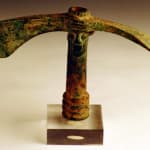Bronze Anthropomorphic Axe Head, 1200 BCE - 800 CE
Bronze
FZ.134
Though we sense its latent power and undoubtedly violent past, we are also captivated by the sculptural beauty of this ancient weapon. It achieves a balance and order with just...
Though we sense its latent power and undoubtedly violent past, we are also captivated by the sculptural beauty of this ancient weapon. It achieves a balance and order with just a touch of humor that appeals to our artistic senses. We are aware of its mysterious, even ominous qualities, yet somehow the passage of time has brought its beauty to the surface.
The Bronze Age was a period in the civilization's development when the most advanced metalworking (at least in systematic and widespread use) consisted of techniques for smelting copper and tin from naturally occurring outcroppings of ore, and then alloying those metals in order to cast bronze. The Bronze Age forms part of the three-age system for prehistoric societies. In that system, it follows the Neolithic in some areas of the world. In many parts of sub-Saharan Africa, the Neolithic is directly followed by the Iron Age.
The place and time of the invention of bronze are controversial, and it is possible that bronzing was invented independently in multiple places. The earliest known tin bronzes are from what is now Iran and Iraq and date to the late 4th millennium BC, but there are claims of an earlier appearance of tin bronze in Thailand in the 5th millennium BC. Arsenical bronzes were made in Anatolia and on both sides of the Caucasus by the early 3rd millennium BC. Some scholars date some arsenical bronze artefacts of the Maykop culture in the North Caucasus as far back as the mid 4th millennium BC, which would make them the oldest known bronzes, but others date the same Maykop artefacts to the mid 3rd millennium BC.
The Bronze Age in the Near East is divided into three main periods (the dates are very approximate):
• EBA - Early Bronze Age (c.3500-2000 BC) • MBA - Middle Bronze Age (c.2000-1600 BC) • LBA - Late Bronze Age (c.1600-1200 BC) Metallurgy developed first in Anatolia, modern Turkey. The mountains in the Anatolian highland possessed rich deposits of copper and tin. Copper was also mined in Cyprus, Egypt, the Negev desert, Iran and around the Persian Gulf. Copper was usually mixed with arsenic, yet the growing demand for tin resulted in the establishment of distant trade routes in and out of Anatolia. The precious copper was also imported by sea routes to the great kingdoms of Ancient Egypt and Mesopotamia.
The Bronze Age was a period in the civilization's development when the most advanced metalworking (at least in systematic and widespread use) consisted of techniques for smelting copper and tin from naturally occurring outcroppings of ore, and then alloying those metals in order to cast bronze. The Bronze Age forms part of the three-age system for prehistoric societies. In that system, it follows the Neolithic in some areas of the world. In many parts of sub-Saharan Africa, the Neolithic is directly followed by the Iron Age.
The place and time of the invention of bronze are controversial, and it is possible that bronzing was invented independently in multiple places. The earliest known tin bronzes are from what is now Iran and Iraq and date to the late 4th millennium BC, but there are claims of an earlier appearance of tin bronze in Thailand in the 5th millennium BC. Arsenical bronzes were made in Anatolia and on both sides of the Caucasus by the early 3rd millennium BC. Some scholars date some arsenical bronze artefacts of the Maykop culture in the North Caucasus as far back as the mid 4th millennium BC, which would make them the oldest known bronzes, but others date the same Maykop artefacts to the mid 3rd millennium BC.
The Bronze Age in the Near East is divided into three main periods (the dates are very approximate):
• EBA - Early Bronze Age (c.3500-2000 BC) • MBA - Middle Bronze Age (c.2000-1600 BC) • LBA - Late Bronze Age (c.1600-1200 BC) Metallurgy developed first in Anatolia, modern Turkey. The mountains in the Anatolian highland possessed rich deposits of copper and tin. Copper was also mined in Cyprus, Egypt, the Negev desert, Iran and around the Persian Gulf. Copper was usually mixed with arsenic, yet the growing demand for tin resulted in the establishment of distant trade routes in and out of Anatolia. The precious copper was also imported by sea routes to the great kingdoms of Ancient Egypt and Mesopotamia.
Literature
V1



